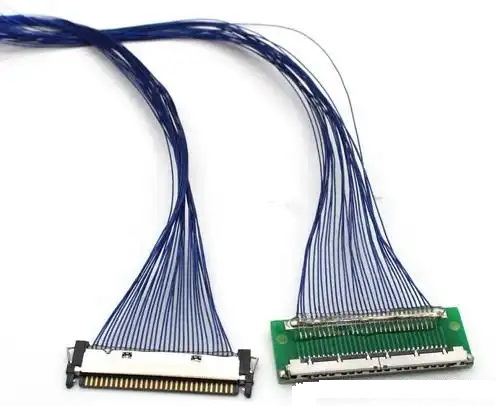In the context of the increasingly slim and integrated nature of electronic products, ultra-thin coaxial cable, with its excellent signal transmission performance and flexibility in wiring, has become the preferred cable for high-end electronic devices such as smartphones, laptops, drones, and medical imaging equipment. The choice of conductor material directly affects the signal quality and reliability of the cable. So, how does the conductor material of the ultra-thin coaxial cable affect signal transmission? This article will provide a detailed analysis for you.

Fine coaxial cable conductor manufacturing process and common specifications
The extremely thin coaxial cable束 is commonly used in equipment with extremely high requirements for signal integrity. The manufacturing process and specifications of its conductor part directly determine the signal performance and flexibility of the cable束.
Conductor manufacturing process:
• Structure: The inner conductor is generally made of a single bare copper wire or a绞合of fine copper wires.
Surface treatment: Plating is carried out according to application requirements, commonly including:
• Silver Plating: Enhances high-frequency signal transmission capability, with excellent antioxidant properties.
Tin Plating: Enhances corrosion resistance, suitable for medium and low-frequency environments.
Nickel Plating: Resistant to high temperatures and oxidation, suitable for high-temperature environments.
Manufacturing process:
• Drawing: Pulling coarse copper rods into micrometer-level fine copper wires.
Interweaving: Multiple fine threads are twisted together at a specific pitch to enhance flexibility and tensile strength.
Coating treatment: Silver, tin or nickel plating is completed online to enhance conductor performance.
Common conductor specifications:
Fine coaxial fiber bundles usually adopt a single or multi-strand braided structure.
• The smaller the single-line diameter, the lower the signal attenuation, the higher the flexibility, but the increased manufacturing difficulty.

The effect of conductor material on signal quality
Conductivity performance
裸铜与镀银铜导电性best,可有效降低resistance,reduce signal loss and delay.
Tin-plated copper is the second choice, suitable for medium and high-speed signals, but has slightly higher loss in high-frequency environments.
High-frequency signal attenuation
High-frequency signals are affected by the skin effect, with the current mainly transmitted along the surface of the conductor.
Silver-plated copper, due to silver's high electrical and thermal conductivity, can significantly reduce high-frequency signal attenuation, and is suitable for high-definition camera module groups and 5G radio frequency antennas.
Antioxidant properties
Silver-plated copper and tin-plated copper have good anti-oxidation properties, which can extend the service life of cables and are suitable for high-temperature and humid environments.
Copper is prone to oxidation, which may affect signal stability over a long period of use, but it is cost-effective and suitable for common consumer electronic devices.
Flexibility and reliability
Copper alloy material has the best flexibility, suitable for micro-space wiring and frequent bending environments, but with slightly higher signal loss.

Three, selection of line suggestions
Silver-plated copper for pursuit of ultimate performance and high-frequency signal stability
Focus on cost-performance and medium-low frequency applications → Bare copper, tin-plated copper
High demand for extremely fine wire diameter and flexibility → Copper alloy

When selecting ultra-fine coaxial cable assemblies, the material of the conductor has a tremendous impact on the signal performance of the ultra-fine coaxial cable assembly, especially in high-frequency, long-distance, and complex environments. Conductivity, surface treatment technology, and antioxidant capacity directly determine signal integrity and equipment reliability. First understand the application scenario, and then start with the conductor material to find the most suitable solution. In the high-frequency era, the material and specification of the conductor directly determine the signal performance and application potential of the cable assembly.
We have been focusing on the design and customization of high-speed signal cable harnesses and ultra-fine coaxial cable harnesses for a long time, committed to providing stable and reliable high-speed interconnect solutions. If you have any related needs or want to learn more, please contact: Manager Zhang.
18913228573 (WeChat same number).



